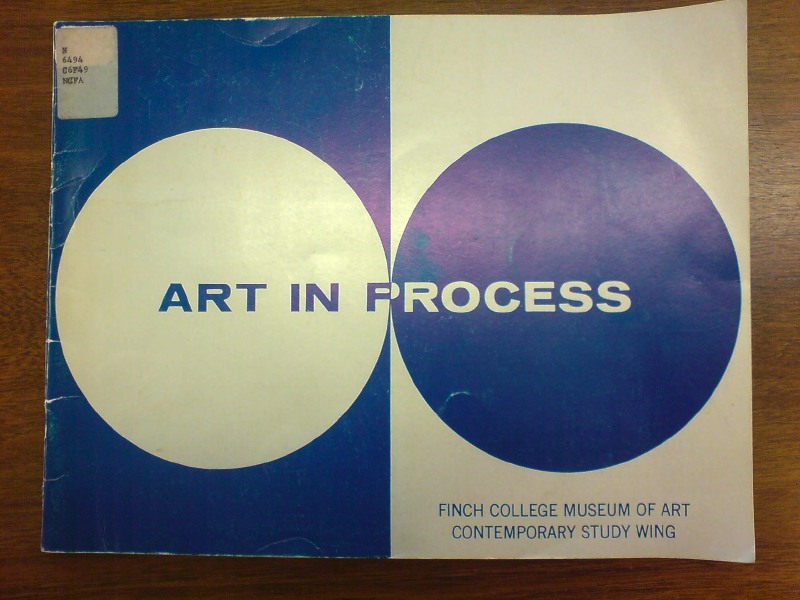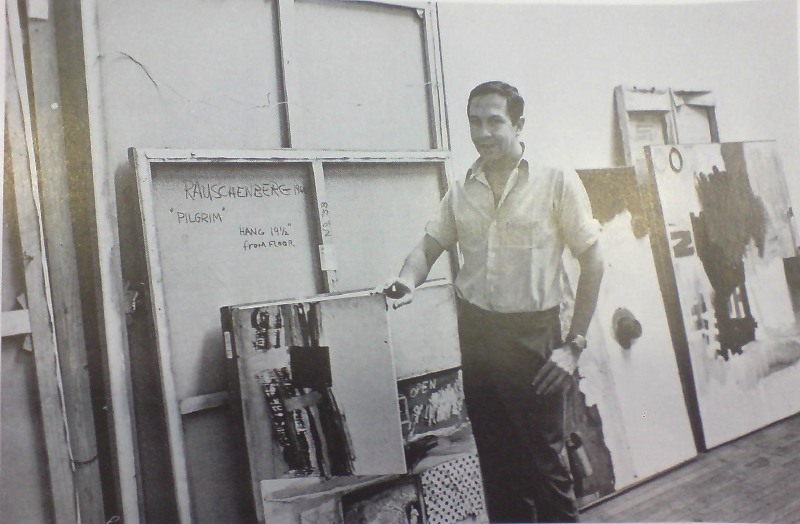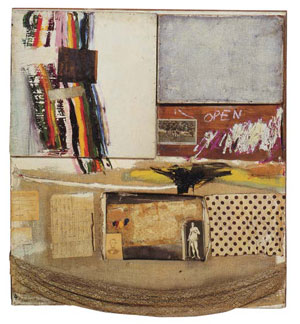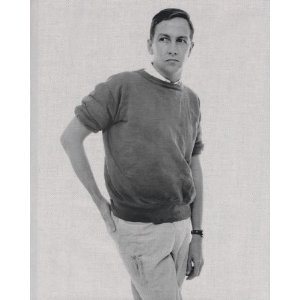
Now we’re getting somewhere, even if it’s only to the library.
Since the Finch College Museum was originally [and wrongly] fingered as the site of the theft of Johns’ Flag from Rauschenberg’s Short Circuit, I’ve been looking for months to buy a copy of the 1967 exhibition catalogue for Art In Process: The Visual Development of a Collage. Well, not so easy. Increasingly desperate and frustrated with the failings of the Internet Age, I decided check the library. Turns out the Smithsonian’s Museum of American Art library, right next door to the Archive of American Art, had a copy. Took like two minutes.
Art In Process was a series of topical, process-oriented, teaching exhibitions organized by Finch College Museum director Elayne Varian. They included sketches, models and studies to show how the artist did what he was doing. From Finch, which was on East 75th Street, the show traveled for 18 months to nine other smaller museums around the country in a tour organized by the American Federation of Arts. [Thanks to the original press release, provided by the AFA, the list of venues is below.]
I’m not the only one who had trouble finding the catalogue, though. Paul Schimmel’s huge Rauschenberg Combines catalogue said the flag painting was stolen while Short Circuit was on exhibit. That’s how he read the entry in Walter Hopps’ 1976 retrospective catalogue, which mentioned Finch and the missing flag together.
But. Check out what Rauschenberg actually said. Well first, check out that photo!

It’s Bob, teasing us with what’s behind Short Circuit Door No. 1. Because there is nothing:
In the third Artist Show at the Stable Gallery, my collage, SHORT CIRCUIT, 1955, was motivated by the protest that there had not been any new artists invited to exhibit. Therefore, I invited four artists: Jasper Johns, Stan Vanderbeek, Sue Weil and Ray Johnson to give me works to be built into my collage. Only two paintings were ready in time to be installed into the major piece. The collage also contains the autograph of Judy Garland, and one of the first programs of a John Cage concert. Because Jasper Johns’ flag for the collage was stolen, Elaine Sturtevant is painting an original flag in the manner of Jasper Johns’ to replace it. This collage is a documentation of a particular event at a particular time and is still being affected. It is a double document.
Give me. Built into. My collage. Only two. Is painting. These are the phrases that jump out at me.
Not only was Art In Process the first acknowledgment of the removal of Johns’ flag, almost two years after it happened, it was the first public exhibition for Short Circuit since Alan Solomon’s group show at Cornell in 1958. After being the subject of some kind of joint, post-breakup negation agreement between Johns and Rauschenberg, where the combine was not exhibited, published, or even, it seems, discussed, Short Circuit went on a cross-country tour, without the flag, and with the doors nailed shut.

I thought I’d be all Errol Morris about it and date the photograph from the other works in the background, but it doesn’t really help: Pilgrim (1960), on the left without its chair; Johanson’s Painting (1961), in the middle, with the tin cans, was in Ileana Sonnabend’s collection; the other combine painting with the N or Z element, I haven’t found yet. [Any ideas? Send’em in!] That watch Bob’s wearing looks like the one in the Avedon photo on the cover of Schimmel’s Combines, which was taken in 1960. But I’ll say Bob’s face looks a few years older, at least five, if not seven.

So this photo was probably not, then, taken before 1965. And Johns’ flag painting is probably not, then, behind that door. And Bob is probably not, then, toying with the terms of the no-repro “solution” he and Johns devised for this double document.
Other things: Sturtevant’s flag sounds like it’s in process. Unless that “Sturtevant is painting an original flag” is the same tense as “I am making an animated musical,” somewhere well short of “she’s delivering it this week,” and closer to “well, we’ve talked about it.” Because though a Sturtevant flag sighting was reported in 1971, There were no photos of Short Circuit for Hopps to publish in 1976, and Rauschenberg talking of painting a flag himself because he “need(s) the therapy.” And when David Shapiro and Hirshhorn curator Cynthia McCabe scouted the combine out in 1985, they had a “very sad experience” looking at the work, in a “state of real disrepair,” with mentions only of the absence of Johns’ flag and none of Sturtevant.
No mention of Ray Johnson’s inclusion. How classic for Johnson’s own collage that it gets subsumed so totally as Rauschenberg’s. It’s as if only the paintings can hold their own against the combine’s powers of assimilation. Resistance is futile. I guess that’s the real question here.
For Johnson, though, it’s probably the giddy answer. He was also included in Art in Process on his own, so don’t sweat for him. If anything, that’s how he wanted it. Here’s writer/artist/curator Sebastian Matthews:
Over the next decade, Johnson made a series of anti-rectangle collages. It wasn’t long before Johnson was mailing out collage fragments “for others to use or send on,” letting go authorship (at least in part) and allowing the work to be formed by increasingly random collaborations. No coincidence, then, that Johnson made this creative leap during his transition from Black Mountain to New York City while hanging out with his BMC buddies.
That’s from Matthews’ proposal/thesis for an awesome-sounding show, BMC to NYC: The Tutelary Years of Ray Johnson, which he organized last fall at Black Mountain College + Arts Center in Asheville, NC. Sounds like Short Circuit was as formative and in harmony with Johnson’s emerging practice as it was problematic for Johns’. That may be too simplistic, but it’s way past time to take a closer look at the rest of Short Circuit, too.
The dimensions: The Finch catalogue lists the dimensions for Short Circuit as 48 x 48 inches, which, since Bob was not seven feet tall in that picture, is obviously wrong.
Another reason for checking the Finch catalogue was to see whether Short Circuit was still owned by Rauschenberg or, if it was still, as Michael Crichton reported, in Leo Castelli’s collection. And it doesn’t say. But the press release might. Artists, like Al Hansen, were listed as lenders for some works in Art In Process, but works were credited to the artists’ dealers. Short Circuit was apparently lent not by Rauschenberg, but by Leo Castelli Gallery. The mounted photocopies of letters to Ray Johnson, Stan Vanderbeck [sic] and Susan Weil, meanwhile, were lent “anonymously.” Wait, the what?

Art In Process: The Visual Development of a Collage, was shown at Finch College Museum of Art in Manhattan, from 9 March to August 1967.
It traveled via the American Federation of Arts to the following venues:
1967
Aug. 24 – Sep. 14: Charles N. MacNider Museum, Mason City, IA
Sep. 28 – Oct. 19: University of Georgia, Athens, GA
Nov. 2 – 23: State University College, Plattsburgh, NY
1968
Jan. 11 – Feb. 1: Cedar Rapids Art Center, Cedar Rapids, IA
Feb. 15 – Mar. 7: The Phillips Collection, Washington, DC
Mar. 21 – Apr. 11: The Neville Public Museum, Green Bay, WI
Apr. 25 – May 16: Wabash College, Crawfordsville, IN
Jul. 4 – 25: State University College, Geneseo, NY
Sep. 12 – Oct. 3: Bates College, Lewiston, ME
